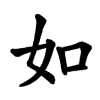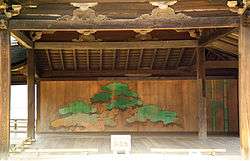Definify.com
Definition 2025
能
能
Translingual
| Stroke order | |||
|---|---|---|---|

| |||
Han character
能 (radical 130 肉+6, 10 strokes, cangjie input 戈月心心 (IBPP), four-corner 21211, composition ⿰䏍⿱匕匕)
Derived characters
References
- KangXi: page 981, character 16
- Dai Kanwa Jiten: character 29454
- Dae Jaweon: page 1433, character 11
- Hanyu Da Zidian: volume 3, page 2074, character 1
- Unihan data for U+80FD
Chinese
|
simp. and trad. |
能 | |
|---|---|---|
Glyph origin
| Historical forms of the character 能
| |||
|---|---|---|---|
| Oracle bone script | Bronze inscriptions | Large seal script | Small seal script |
 |
 |
 |
 |
| Characters in the same phonetic series (能) (Zhengzhang, 2003) | |
|---|---|
| Old Chinese | |
| 態 | *n̥ʰɯːs |
| 能 | *nɯː, *nɯːs, *nɯːŋ, *nɯːŋʔ |
| 螚 | *nɯːs |
| 褦 | *nɯːs |
Pictogram (象形) : bear. Compare 熊 (OC *ɢʷlɯm, “bear”).
Etymology
“Be able to; can; ability”. Shijing rhymes point to Old Chinese *nə, but the forms with *-ŋ are also archaic (perhaps ancient dialectal variation?).
Possibly Sino–Tibetan: compare Tibetan ནུས་པ (nus pa, “be able to; capable; to withstand; capacity; strength; force; power; function; energy”), Burmese နိုင် (nuing, “can, be able to, may; master; win; prevail”). Schuessler (2007) also derives 態 (OC *n̥ʰɯːs, “apparition, bearing, manner”) from this.
Compare the old Sino–Vietnamese loanword nổi (“be able to; capable”).
Pronunciation 1
- Mandarin
- Cantonese (Jyutping): nang4
- Hakka (Sixian, PFS): nên
- Min Dong (BUC): nèng
- Min Nan (POJ): nn̂g / lêng
- Wu (Wiktionary): nen (T3)
- Mandarin
- (Standard Chinese, Beijing)+
- Pinyin:
- Zhuyin: ㄋㄥˊ
- Wade-Giles: nêng2
- Gwoyeu Romatzyh: neng
- IPA (key): /nɤŋ³⁵/
-

- (Standard Chinese, Beijing)+
- Cantonese
- (Standard Cantonese, Guangzhou)+
- Jyutping: nang4
- Yale: nàhng
- Cantonese Pinyin: nang4
- IPA (key): /nɐŋ²¹/
- (Standard Cantonese, Guangzhou)+
- Hakka
- (Sixian, incl. Miaoli and Meinong)
- Pha̍k-fa-sṳ: nên
- Hakka Romanization System: nen´
- Hagfa Pinyim: nen1
- IPA: /nen²⁴/
- (Sixian, incl. Miaoli and Meinong)
- Min Dong
- (Fuzhou)
- Bàng-uâ-cê: nèng
- IPA (key): /nˡɛiŋ⁵³/
- (Fuzhou)
- Min Nan
- (Hokkien: Quanzhou)
- Pe̍h-ōe-jī: nn̂g
- Tâi-lô: nn̂g
- Phofsit Daibuun: nngg
- IPA (Quanzhou): /nŋ̍²⁴/
- (Hokkien: mainstream Taiwanese, Xiamen, Zhangzhou)
- Pe̍h-ōe-jī: lêng
- Tâi-lô: lîng
- Phofsit Daibuun: leeng
- IPA (Taipei): /liɪŋ²⁴/
- IPA (Kaohsiung): /liɪŋ²³/
- IPA (Xiamen): /liɪŋ²⁴/
- IPA (Zhangzhou): /liɪŋ¹³/
- (Hokkien: Quanzhou)
- Wu
- (Shanghainese)
- Wiktionary: nen (T3)
- IPA (key): /nəɲ²³/
- (Shanghainese)
- Dialectal data▼
| Variety | Location | 能 |
|---|---|---|
| Mandarin | Beijing | /nəŋ³⁵/ |
| Harbin | /nəŋ²⁴/ | |
| Tianjin | /nəŋ⁴⁵/ | |
| Jinan | /nəŋ⁴²/ | |
| Qingdao | /nəŋ⁴²/ | |
| Zhengzhou | /nəŋ⁴²/ | |
| Xi'an | /nəŋ²⁴/ | |
| Xining | /nə̃²⁴/ | |
| Yinchuan |
/nəŋ⁴⁴/ 打~~ /nəŋ⁵³/ ~幹 |
|
| Lanzhou | /lə̃n⁵³/ | |
| Ürümqi | /nɤŋ⁵¹/ | |
| Wuhan | /nən²¹³/ | |
| Chengdu | /nən³¹/ | |
| Guiyang | /nen²¹/ | |
| Kunming | /nə̃³¹/ | |
| Nanjing | /lən²⁴/ | |
| Hefei | /lən⁵⁵/ | |
| Jin | Taiyuan | /nəŋ¹¹/ |
| Pingyao | /nəŋ¹³/ | |
| Hohhot | /nə̃ŋ³¹/ | |
| Wu | Shanghai | /nəŋ²³/ |
| Suzhou | /nən¹³/ | |
| Hangzhou | /nen²¹³/ | |
| Wenzhou | /naŋ³¹/ | |
| Hui | Shexian | /lʌ̃⁴⁴/ |
| Tunxi | /lɛ⁴⁴/ | |
| Xiang | Changsha | /lən¹³/ |
| Xiangtan | /nən¹²/ | |
| Gan | Nanchang | /lɛn⁴⁵/ |
| Hakka | Meixian | /nen¹¹/ |
| Taoyuan | /nen¹¹/ | |
| Cantonese | Guangzhou | /nɐŋ²¹/ |
| Nanning | /nɐŋ²¹/ | |
| Hong Kong | /nɐŋ²¹/ | |
| Min | Xiamen (Min Nan) | /liŋ³⁵/ |
| Fuzhou (Min Dong) | /nɛiŋ⁵³/ | |
| Jian'ou (Min Bei) | /naiŋ²¹/ | |
| Shantou (Min Nan) | /leŋ⁵⁵/ | |
| Haikou (Min Nan) |
/neŋ³¹/ /nɔŋ³¹/ |
| Rime | ||||
|---|---|---|---|---|
| Character | 能 | 能 | 能 | 能 |
| Reading # | 1/4 | 2/4 | 3/4 | 4/4 |
| Initial (聲) | 泥 (8) | 泥 (8) | 泥 (8) | 泥 (8) |
| Final (韻) | 咍 (41) | 登 (129) | 登 (129) | 咍 (41) |
| Tone (調) | Level (Ø) | Level (Ø) | Rising (X) | Departing (H) |
| Openness (開合) | Open | Open | Open | Open |
| Division (等) | I | I | I | I |
| Fanqie | 奴來切 | 奴登切 | 奴等切 | 奴代切 |
| Reconstructions | ||||
| Zhengzhang Shangfang |
/nʌi/ | /nəŋ/ | /nəŋX/ | /nʌiH/ |
| Pan Wuyun |
/nəi/ | /nəŋ/ | /nəŋX/ | /nəiH/ |
| Shao Rongfen |
/nɒi/ | /nəŋ/ | /nəŋX/ | /nɒiH/ |
| Edwin Pulleyblank |
/nəj/ | /nəŋ/ | /nəŋX/ | /nəjH/ |
| Li Rong |
/nᴀi/ | /nəŋ/ | /nəŋX/ | /nᴀiH/ |
| Wang Li |
/nɒi/ | /nəŋ/ | /nəŋX/ | /nɒiH/ |
| Bernard Karlgren |
/nɑ̆i/ | /nəŋ/ | /nəŋX/ | /nɑ̆iH/ |
| Expected Mandarin Reflex |
nái | néng | něng | nài |
- Old Chinese▼
- (Baxter-Sagart): /*nˤə/, /*nˤə(ŋ)/, /*nˤə(ʔ)/
- (Zhengzhang): /*nɯː/, /*nɯːs/, /*nɯːŋ/, /*nɯːŋʔ/
| Baxter-Sagart system 1.1 (2014) | |||
|---|---|---|---|
| Character | 能 | 能 | 能 |
| Reading # | 1/3 | 2/3 | 3/3 |
| Modern Beijing (Pinyin) |
néng | néng | néng |
| Middle Chinese |
‹ noj › | ‹ nong › | ‹ nong › |
| Old Chinese |
/*nˤə/ | /*nˤə(ŋ)/ | /*nˤə(ʔ)/ (~ *nˤəŋ) |
| English | a kind of bear | a kind of bear | able; ability |
Notes for Old Chinese notations in the Baxter-Sagart system: * Parentheses "()" indicate uncertain presence; | |||
| Zhengzhang system (2003) | ||||
|---|---|---|---|---|
| Character | 能 | 能 | 能 | 能 |
| Reading # | 1/4 | 2/4 | 3/4 | 4/4 |
| No. | 9411 | 9413 | 9415 | 9416 |
| Phonetic component |
能 | 能 | 能 | 能 |
| Rime group |
之 | 之 | 蒸 | 蒸 |
| Rime subdivision |
0 | 0 | 0 | 0 |
| Corresponding MC rime |
能 | 耐 | 能 | 能 |
| Old Chinese |
/*nɯː/ | /*nɯːs/ | /*nɯːŋ/ | /*nɯːŋʔ/ |
Definitions
能
- †A mythological bear-like animal, with deer-like legs.
- able; capable
- can; to be able to; to be capable of
- may
- rather; would rather
- ability; capability
- 能力 ― nénglì ― capability, ability
- talent; talented person
- 才能 ― cáinéng ― talent, ability
- energy; power
- A surname. Neng
Compounds
|
|
|
Pronunciation 2
- Mandarin
- (Standard Chinese, Beijing)+
- Pinyin:
- Zhuyin: ㄋㄞˋ
- Wade-Giles: nai4
- Gwoyeu Romatzyh: nay
- IPA (key): /naɪ̯⁵¹/
- (Standard Chinese, Beijing)+
- Cantonese
- (Standard Cantonese, Guangzhou)+
- Jyutping: noi6
- Yale: noih
- Cantonese Pinyin: noi6
- IPA (key): /nɔːi̯²²/
- (Standard Cantonese, Guangzhou)+
- Wu
- (Shanghainese)
- Wiktionary: ne (T3)
- IPA (key): /nᴇ²³/
- (Shanghainese)
| Rime | |
|---|---|
| Character | 能 |
| Reading # | 4/4 |
| Initial (聲) | 泥 (8) |
| Final (韻) | 咍 (41) |
| Tone (調) | Departing (H) |
| Openness (開合) | Open |
| Division (等) | I |
| Fanqie | 奴代切 |
| Reconstructions | |
| Zhengzhang Shangfang |
/nʌiH/ |
| Pan Wuyun |
/nəiH/ |
| Shao Rongfen |
/nɒiH/ |
| Edwin Pulleyblank |
/nəjH/ |
| Li Rong |
/nᴀiH/ |
| Wang Li |
/nɒiH/ |
| Bernard Karlgren |
/nɑ̆iH/ |
| Expected Mandarin Reflex |
nài |
Definitions
能
Pronunciation 3
- Mandarin
- (Standard Chinese, Beijing)+
- Pinyin:
- Zhuyin: ㄊㄞˊ
- Wade-Giles: t'ai2
- Gwoyeu Romatzyh: tair
- IPA (key): /tʰaɪ̯³⁵/
- (Standard Chinese, Beijing)+
- Cantonese
- (Standard Cantonese, Guangzhou)+
- Jyutping: toi4
- Yale: tòih
- Cantonese Pinyin: toi4
- IPA (key): /tʰɔːi̯²¹/
- (Standard Cantonese, Guangzhou)+
Definitions
能
- †Alternative form of 台 (“name of a Chinese constellation”).
- 三能 ― sāntái ― Santai (Chinese constellation)
Pronunciation 4
- Mandarin
- (Standard Chinese, Beijing)+
- Pinyin:
- Zhuyin: ㄊㄞˋ
- Wade-Giles: t'ai4
- Gwoyeu Romatzyh: tay
- IPA (key): /tʰaɪ̯⁵¹/
- (Standard Chinese, Beijing)+
- Cantonese
- (Standard Cantonese, Guangzhou)+
- Jyutping: taai3
- Yale: taai
- Cantonese Pinyin: taai3
- IPA (key): /tʰɑːi̯³³/
- (Standard Cantonese, Guangzhou)+
Definitions
能
Pronunciation 5
- Mandarin
- (Standard Chinese, Beijing)+
- Pinyin:
- Zhuyin: ㄋㄞˊ
- Wade-Giles: nai2
- Gwoyeu Romatzyh: nai
- IPA (key): /naɪ̯³⁵/
- (Standard Chinese, Beijing)+
| Rime | |
|---|---|
| Character | 能 |
| Reading # | 1/4 |
| Initial (聲) | 泥 (8) |
| Final (韻) | 咍 (41) |
| Tone (調) | Level (Ø) |
| Openness (開合) | Open |
| Division (等) | I |
| Fanqie | 奴來切 |
| Reconstructions | |
| Zhengzhang Shangfang |
/nʌi/ |
| Pan Wuyun |
/nəi/ |
| Shao Rongfen |
/nɒi/ |
| Edwin Pulleyblank |
/nəj/ |
| Li Rong |
/nᴀi/ |
| Wang Li |
/nɒi/ |
| Bernard Karlgren |
/nɑ̆i/ |
| Expected Mandarin Reflex |
nái |
Definitions
能
- † A three-legged soft-shelled turtle.
Pronunciation 6
- Mandarin
- (Standard Chinese, Beijing)+
- Pinyin:
- Zhuyin: ㄊㄞ
- Wade-Giles: t'ai1
- Gwoyeu Romatzyh: tai
- IPA (key): /tʰaɪ̯⁵⁵/
- (Standard Chinese, Beijing)+
Definitions
能
- †Only used in 能始 (“origin, root cause”).
Pronunciation 7
- Mandarin
- (Standard Chinese, Beijing)+
- Pinyin:
- Zhuyin: ㄒㄩㄥˊ
- Wade-Giles: hsiung2
- Gwoyeu Romatzyh: shyong
- IPA (key): /ɕi̯ʊŋ³⁵/
- (Standard Chinese, Beijing)+
- Cantonese
- (Standard Cantonese, Guangzhou)+
- Jyutping: hung4
- Yale: hùhng
- Cantonese Pinyin: hung4
- IPA (key): /hʊŋ²¹/
- (Standard Cantonese, Guangzhou)+
Definitions
能
- †Alternative form of 熊 (xióng, “bear”).
Japanese

Kanji
Readings
- Goon: のう (nō), の (no), ない (nai)
- Kan’on: どう (dō), だい (dai)
- Kan’yōon: たい (tai)
- Kun: 能う (あた・う, ata-u), 能く (よ・く, yo-ku), 能くする (よ・くする, yo-ku suru)
Compounds
Noun
- Noh, a form of classical Japanese musical drama.
- Ability, capacity, aptitude.
- Effect, use.
- 古い議論を繰り返しても能はないのだよ。
- Furui giron o kurikaeshite mo nō wa nai no da yo.
- Repeating old arguments isn't of any use / won't have any effect.
- 古い議論を繰り返しても能はないのだよ。
Synonyms
- (drama): 能楽 (nōgaku)